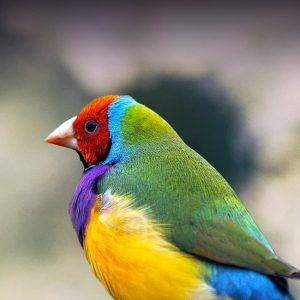
The Gouldian finch is prized primarily for its gorgeous plumage. This small bird is available in a variety of striking, vibrant colors.
The Gouldian finch, also referred to as the Lady Gouldian finch and the rainbow finch, is prized primarily for its gorgeous plumage. It occurs naturally in a variety of striking colors, and is generally differentiated in name by the color of the head. For example, the black-headed, the red-headed, and the yellow-headed Gouldian are some of the available types, though some of the other mutations are distinguished in name by body color. In the wild grasslands of Australia, where they originate, they do not vary as much in color as they do in captivity. There, most Gouldians have a black head, and only a small percentage have a red head. Approximately one percent of wild individuals have an orange head.
Native Region / Natural Habitat
Gouldian finches are native to the grasslands of Australia. Gouldians were then trapped and exported in large numbers from Australia until the late 1960s. Exporting the birds reduced the population of Gouldians considerably in the wild. Grazing cattle and the creation of farmland further challenged the Gouldian, and today it is estimated that that there are fewer than 2,500 mature Gouldians living in the wild. Fortunately, they are heavily bred in captivity.
Care & Feeding
As with most finches, the Gouldian is a quiet enough bird that peeps and sings a little. They make a pleasant sound that is doubtful to wake you up or create a problem with neighbors, though it is persistent. The granule-sized Premium Daily Diet for finches by Lafeber is perfectly sized for finches and provides optimum nutrition.
Personality & Behavior
Gouldians are pleasant "watching only" birds - they don't like to be held, and can even panic and die when handled. Stress is deadly for these fragile birds. They are not typically hand-raised (only under emergency circumstances), and will not take well to taming efforts. They are lovely to watch, but not to hold. If properly cared for, these birds are reported to live for more than 4 to 6 years.
Speech & Sound
Gouldians aren't the easiest finches to keep, being much less hardy than other popular finches, like the zebra finch and society finch. They aren't recommended as first birds because they are delicate and can be overcome in extreme temperatures and are prone to a variety of ailments that a novice bird guardian may not recognize until it may be too late.
Gouldians are among the most difficult finches to breed successfully because they are not wonderful parents and have a tendency to abandon both eggs and babies, or even refuse to nest at all. People who raise Gouldians usually keep society finches as well to serve as foster parents for eggs and babies. Societies are marvelous parents and will be happy to foster other species. You can put plastic eggs beneath the Gouldians as the eggs are removed to be placed with the society finches. Some Gouldian pairs do make decent parents, however.
Goulds should be at least a year old before they are bred. They prefer to nest in a small, covered space, like a wooden nest box or covered basket. The box is preferred because the finch can't accidentally catch a toe in the woven straw, and the box is also easier to access. Gouldians don't build great nests, so put some material in the nest to get the parents started.
The finches lay between three and six eggs that hatch a little over two weeks after being laid. About three weeks later the babies are ready to leave the nest, and about a week later they are eating on their own. The babies should be served millet spray and eggfood, as well as other soft foods that they can digest easily.
Gouldians are small, but they make great aviary birds and appreciate a large, planted garden setting. If they're given enough space, they will get along with society finches and zebra finches, but not weavers or whydahs,both of which can be bullies. Finches need a lot of exercise, so their housing should be large enough to allow flight. If the cage is too small, their lifespan will be reduced and the female might not get enough exercise to maintain good breeding condition, resulting in egg binding and even death. Cage bars should be no more than 1/2 inch apart, and the cage should have doors large enough for feeding, watering, and cleaning, but not so large that the finches will escape when opened.
A finch will thrive on a pelleted base diet, such as Lafeber's Premium Daily Diet specifically designed for finches. These birds are primarily seed-eaters in the wild, so there diet should be supplements with a high-quality seed mix They should also get a rotation of grubs, greens, eggfood, and other veggies daily. They can have a small amount of grit and charcoal in the diet, but not much. A cuttlebone should be in the cage at all times.
Health & Common Conditions
Gouldian finches are prone to air-sac mite infection, especially when overly stressed. This is a serious medical condition that warrants immediately veterinary care. If caught early enough, a finch can be successfully treated. Gouldian finches can also be susceptible to scaly face (a condition caused by a mite that presents as white, scaly areas around the beak/eyes, as well as the legs), which warrants a call to the vet. Finches can also have overgrown nails or beaks, which should be addressed by an experienced bird groomer or vet.
:max_bytes(150000):strip_icc():format(webp)/what-horses-eat-that-keep-them-healthy-1886504-FINAL-5ba8dd3746e0fb0025eb2cb4.png)
:max_bytes(150000):strip_icc():format(webp)/horse-eye-resized-56a4dbf03df78cf77284fe95.jpg)
:max_bytes(150000):strip_icc():format(webp)/Horse-grooming-GettyImages-495726400-5876f27d5f9b584db351222e.jpg)
:max_bytes(150000):strip_icc():format(webp)/close-up-of-hand-holding-parrot-705172843-5b52bc4ec9e77c0037b6e5a4.jpg)
:max_bytes(150000):strip_icc():format(webp)/GettyImages-579524112-5c77331146e0fb000140a3a6.jpg)
:max_bytes(150000):strip_icc():format(webp)/budgerigarsonrope-331834_1920-5b628213c9e77c00255b32bc.jpg)
:max_bytes(150000):strip_icc():format(webp)/GettyImages-106887241-58325bc03df78c6f6a9a2ed2.jpg)
:max_bytes(150000):strip_icc():format(webp)/GettyImages-878015800-06106157c9d34a2081db4abcae8699b1.jpg)
:max_bytes(150000):strip_icc():format(webp)/hungry-cat-57b72fac5f9b58cdfda11a62.jpg)


:max_bytes(150000):strip_icc():format(webp)/4374985466_59c7f6545b_o-8b4f24f2f3e544349fe537fde58cfad0.jpg)
:max_bytes(150000):strip_icc():format(webp)/GettyImages-9298737261-500c5a2fba4248f89d1c17a33bf438f7.jpg)
:max_bytes(150000):strip_icc():format(webp)/veterinarian-and-owners-examining-dog-in-vet-s-surgery-164853745-dbecbdb691d549d79487d84356920cf4.jpg)